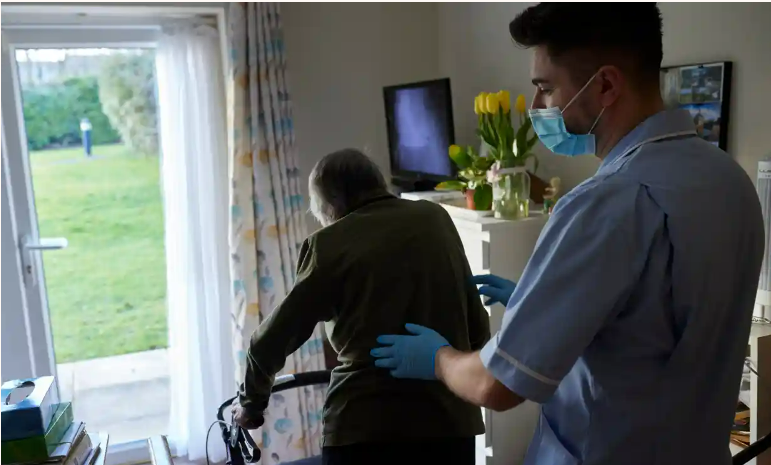Massive social care reforms can wait since houses urgently want funds and laborers.

On Thursday, I had a conversation with a hospital physician in North East England who does acute medicine, a broad word that encompasses the majority of crises, from heart attacks to kidney failure. The medical workers’ advocacy group EveryDoctor, which was founded shortly before the pandemic, put me in touch with her. She informed me, “I’ve never seen anything like this.” “The hallways are jam-packed with patients being cared for on trolleys. Even though our A&E department has doubled in capacity since the pandemic, it is still overflowing with patients waiting for beds.
She claimed that a particularly poor flu season, a dramatic increase in respiratory viruses, and serious structural issues that had been lingering for years were what had brought her institution to the brink of collapse. She expressed her concerns in what appeared to be the calm tones of someone who frequently deals with questions of life and death, but what she said was filled with dread and the impression that the social contract’s fundamental tenets had crumbled. “I believe the majority of people would say that after they entered the doors, they would be as safe as possible if they were seriously ill. It appears that is no longer the case. There is simply too much risk.
Our chat contained one particular detail that was revealing. A fundamental problem that hangs over this winter is the reality of an aging society and how little has been done to prepare for it. It frequently flipped from the state of the NHS to the equally dire condition of adult social care, which is managed by councils and largely provided by private providers. Huge gaps in the system leave patients who should be discharged from the hospital detained there. Low pay, significant staff turnover, and persistent austerity continue to define how we address society’s demands for care. Furthermore, many elderly persons might not even need to be hospitalized if social care was halfway adequate. It is obvious that one crisis cannot exist without the other.
McCarthy faces a new challenge when the House votes on a rules package following a turbulent week.
Up to 13,000 NHS patients, or up to 13% of hospital beds, are reported “medically ready to leave the hospital, but have to stay because there is nowhere else for them to go,” according to the president of the Royal College of Emergency Medicine. The number of patients in my doctor contact’s hospital was in line with her estimate, and she also informed me that the single biggest challenge facing her coworkers at the moment was bed blocking caused by subpar social care: “If that issue was sorted, we might be able to handle.” Additionally, the issue is awful from a human perspective: “People who are stuck in wards experience a lot of misery. It most definitely hinders their recuperation. Nobody improves in a hospital after a certain point.
She continued by saying that lately, it has been challenging to even receive care packages for people who are near the end of their lives. “In the past, we could arrange for a patient I saw to go home to die if their cancer had progressed. Now, that frequently isn’t possible because home care just isn’t available.
In England, journalists and politicians frequently focus on the enormous care costs borne by wealthier households and the financing reforms that have been deferred until 2025. But what about social care as a whole? A record number of nursing facilities are closing their doors, in part due to increased energy prices. A shortage of workers prevented the delivery of more than two million hours of home care annually in the first three months of last year, according to the Care and Quality Commission. Approximately 300,000 people in England were reportedly on waiting lists for an evaluation of their care needs by the end of the summer, with 600 more people signing up every day, according to reliable statistics.
The background to all of this is depressingly well known: David Cameron, George Osborne, and Nick Clegg pushed irresponsible austerity that flew in the face of increasing need. Eight years ago, I first overheard local government officials discussing how hospital beds were being blocked by social care cuts. More lately, periodic but insufficient funding has been followed by sporadic discussion of reform, but there hasn’t seemed to be anyone able to stop the failures from getting worse. In addition to the £500 million previously allocated to a new “discharge fund,” there was word over the weekend of further emergency expenditure – “hundreds of millions of pounds,” according to the front page of the Sunday Times – to block-buy spaces in care homes and free up NHS beds. These actions may be well-intended, but they lack strategic coherence since they ignore the root causes of the situation.
Top 10 Platforms For Affiliate Marketing Software To Increase
Would you accept a job as a care worker for £18,000 per year? was the appropriate question Laura Kuenssberg posed to the prime minister on Sunday morning. He didn’t respond. About 50% of workers in the sector make less than the minimum wage of 30p per hour. Brexit simmers away in the background, contributing to the growing labor shortages in the sector and setting off other, more indirect repercussions, such as the exodus of workers from the care industry in increasing numbers due to job openings in other industries. Adult social care had a 5.9% vacancy rate in 2021; a year later, it was 10%. Although there are currently roughly 165,000 open positions in the sector, it is apparent that we will need an ever-increasing number of individuals to staff the care system in the future.
Despite the fact that Westminster politicians are mostly to blame for this disaster, there are widespread issues in the UK that are only now getting a variety of extremely late solutions. The SNP government in Scotland is attempting to consolidate services into a new national care service despite strong opposition; Labour in England talks incoherently about a national system that would develop “over several parliaments,” while Tory ministers paint the Health and Care Act of 2022 as a turning point in “how health and care services work together.” But there is one point that social care insiders keep making: before we have any significant discussions about broad change, the urgency of our current crises needs to be reduced by paying workers more right away and stabilizing a precarious system. Contrary to what Rishi Sunak and Keir Starmer claim, there isn’t an instant solution to this situation that doesn’t entail significant sums of money, spent continuously, and a big number of care providers.
There are two practical methods to ensure such things: a thriving economy that will generate enough tax income, and a true openness to immigrants. But for reasons that hardly need to be mentioned, we are no longer that kind of nation. The over-65s voted 64% in favor of leaving the EU, encouraged by the same charlatans who now complain about a “broken” Britain. People nearing the end of their lives, confined to hospital wards, clutching on to a dwindling hope that they may somehow make it home—that sad irony is one more aspect of a winter marked by turmoil and carnage and one symbolic image that yet appears forgotten.





